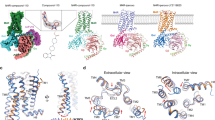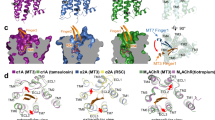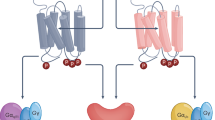Abstract
The generation of muscarinic acetylcholine receptor (mAChR) subtype-selective compounds has been challenging, requiring use of nonpharmacological approaches, such as genetically engineered animals, to deepen our understanding of the potential that members of the muscarinic receptor subtype family hold as therapeutic drug targets. The muscarinic receptor agonist ‘BuTAC’ was previously shown to exhibit efficacy in animal models of psychosis, although the particular receptor subtype(s) responsible for such activity was unclear. Here, we evaluate the in vitro functional agonist and antagonist activity of BuTAC using an assay that provides a direct measure of G protein activation. In addition, we employ the conditioned avoidance response paradigm, an in vivo model predictive of antipsychotic activity, and mouse genetic deletion models to investigate which presynaptic mAChR subtype mediates the antipsychotic-like effects of BuTAC. Our results show that, in vitro, BuTAC acts as a full agonist at the M2AChR and a partial agonist at the M1 and M4 receptors, with full antagonist activity at M3- and M5AChRs. In the mouse conditioned avoidance response (CAR) assay, BuTAC exhibits an atypical antipsychotic-like profile by selectively decreasing avoidance responses at doses that do not induce escape failures. CAR results using M2−/−, M4−/−, and M2/M4 (M2/M4−/−) mice found that the effects of BuTAC were near completely lost in M2/M4−/− double-knockout mice and potency of BuTAC was right-shifted in M4−/− as compared with wild-type and M2−/− mice. The M2/M4−/− mice showed no altered sensitivity to the antipsychotic effects of either haloperidol or clozapine, suggesting that these compounds mediate their actions in CAR via a non-mAChR-mediated mechanism. These data support a role for the M4AChR subtype in mediating the antipsychotic-like activity of BuTAC and implicate M4AChR agonism as a potential novel therapeutic mechanism for ameliorating symptoms associated with schizophrenia.
Similar content being viewed by others
Log in or create a free account to read this content
Gain free access to this article, as well as selected content from this journal and more on nature.com
or
References
Arnsten AF (2011). Catecholamine influences on dorsolateral prefrontal cortical networks. Biol Psychiatry 69: e89–e99.
Bernard V, Normand E, Bloch B (1992). Phenotypical characterization of the rat striatal neurons expressing muscarinic receptor genes. J Neurosci 12: 3591–3600.
Bolden C, Cusack B, Richelson E (1992). Antagonism by antimuscarinic and neuroleptic compounds at the five cloned human muscarinic cholinergic receptors expressed in Chinese hamster ovary cells. J Pharmacol Exp Ther 260: 576–580.
Bymaster FP, Carter PA, Yamada M, Gomeza J, Wess J, Hamilton SE et al (2003a). Role of specific muscarinic receptor subtypes in cholinergic parasympathomimetic responses, in vivo phosphoinositide hydrolysis, and pilocarpine-induced seizure activity. Eur J Neurosci 17: 1403–1410.
Bymaster FP, Felder C, Ahmed S, McKinzie D (2002). Muscarinic receptors as a target for drugs treating schizophrenia. Curr Drug Targets CNS Neurol Disord 1: 163–181.
Bymaster FP, McKinzie DL, Felder CC, Wess J (2003b). Use of M1-M5 muscarinic receptor knockout mice as novel tools to delineate the physiological roles of the muscarinic cholinergic system. Neurochem Res 28: 437–442.
Bymaster FP, Shannon HE, Rasmussen K, Delapp NW, Mitch CH, Ward JS et al (1998). Unexpected antipsychotic-like activity with the muscarinic receptor ligand (5R,6R)6-(3-propylthio-1,2,5-thiadiazol-4-yl)-1-azabicyclo[3.2.1]octane. Eur J Pharmacol 356: 109–119.
Chan WY, McKinzie DL, Bose S, Mitchell SN, Witkin JM, Thompson RC et al (2008). Allosteric modulation of the muscarinic M4 receptor as an approach to treating schizophrenia. Proc Natl Acad Sci USA 105: 10978–10983.
DeLapp NW, McKinzie JH, Sawyer BD, Vandergriff A, Falcone J, McClure D et al (1999). Determination of [35 S]guanosine-5′-O-(3-thio)triphosphate binding mediated by cholinergic muscarinic receptors in membranes from Chinese hamster ovary cells and rat striatum using an anti-G protein scintillation proximity assay. J Pharmacol Exp Ther 289: 946–955.
Dencker D, Wortwein G, Weikop P, Jeon J, Thomsen M, Sager TN et al (2011). Involvement of a subpopulation of neuronal M4 muscarinic acetylcholine receptors in the antipsychotic-like effects of the M1/M4 preferring muscarinic receptor agonist xanomeline. J Neurosci 31: 5905–5908.
Dencker D, Weikop P, Sørensen G, Woldbye DPD, Wörtwein G, Wess J et al (2012). An allosteric enhancer of M4 muscarinic acetylcholine receptor function inhibits behavioral and neurochemical effects of cocaine. Psychopharmacology 224: 277–287.
Felder CC, Bymaster FP, Ward J, DeLapp N (2000). Therapeutic opportunities for muscarinic receptors in the central nervous system. J Med Chem 43: 4333–4353.
Feldman RS, Meyer JS, Quenzer LF (1997) Principles of Neuropsychopharmacology. Sinauer Associates: Sunderland, MA.
Fink-Jensen A, Schmidt LS, Dencker D, Schülein C, Wess J, Wörtwein G et al (2011). Antipsychotic-induced catalepsy is attenuated in mice lacking the M4 muscarinic acetylcholine receptor. Eur J Pharmacol 656: 39–44.
Forster GL, Yeomans JS, Takeuchi J, Blaha CD (2002). M5 muscarinic receptors are required for prolonged accumbal dopamine release after electrical stimulation of the pons in mice. J Neurosci 22: RC190.
Gerber DJ, Sotnikova TD, Gainetdinov RR, Huang SY, Caron MG, Tonegawa S (2001). Hyperactivity elevated dopaminergic transmission and response to amphetamine in M1 muscarinic acetylcholine receptor-deficient mice. Proc Natl Acad Sci USA 98: 15312–15317.
Gomeza J, Shannon H, Kostenis E, Felder C, Zhang L, Brodkin J et al (1999a). Pronounced pharmacologic deficits in M2 muscarinic acetylcholine receptor knockout mice. Proc Natl Acad Sci USA 96: 1692–1697.
Gomeza J, Zhang L, Kostenis E, Felder CC, Bymaster FP, Brodkin J et al (2001). Generation and pharmacological analysis of M-2 and M-4 muscarinic receptor knockout mice. Life Sci 68: 2457–2466.
Gomeza J, Zhang L, Kostenis E, Felder C, Bymaster F, Brodkin J et al (1999b). Enhancement of D1 dopamine receptor-mediated locomotor stimulation in M(4) muscarinic acetylcholine receptor knockout mice. Proc Natl Acad Sci USA 96: 10483–10488.
He M, Shippenberg TS (2000). Strain differences in basal and cocaine-evoked dopamine dynamics in mouse striatum. J Pharmacol Exp Ther 293: 121–127.
Hersch SM, Gutekunst CA, Rees HD, Heilman CJ, Levey AI (1994). Distribution of m1-m4 muscarinic receptor proteins in the rat striatum: light and electron microscopic immunocytochemistry using subtype-specific antibodies. J Neurosci 14: 3351–3363.
Ince E, Ciliax BJ, Levey AI (1997). Differential expression of D1 and D2 dopamine and m4 muscarinic acetylcholine receptor proteins in identified striatonigral neurons. Synapse 27: 357–366.
Jones CK, Eberle EL, Shaw DB, McKinzie DL, Shannon HE (2005). Pharmacologic interactions between the muscarinic cholinergic and dopaminergic systems in the modulation of prepulse inhibition in rats. J Pharmacol Exp Ther 312: 1055–1063.
Kristiansen K (2004). Molecular mechanisms of ligand binding, signaling, and regulation within the superfamily of G-protein-coupled receptors: molecular modeling and mutagenesis approaches to receptor structure and function. Pharmacol Ther 103: 21–80.
Ma AW, Pawagi AB, Wells JW (2008). Heterooligomers of the muscarinic receptor and G proteins purified from porcine atria. Biochem Biophys Res Commun 374: 128–133.
Michal P, Lysikova M, El-Fakahany EE, Tucek S (1999). Clozapine interaction with the M2 and M4 subtypes of muscarinic receptors. Eur J Pharmacol 376: 119–125.
Olianas MC, Maullu C, Onali P (1999). Mixed agonist-antagonist properties of clozapine at different human cloned muscarinic receptor subtypes expressed in Chinese hamster ovary cells. Neuropsychopharmacology 20: 263–270.
Perry KW, Nisenbaum LK, George CA, Shannon HE, Felder CC, Bymaster FP (2001). The muscarinic agonist xanomeline increases monoamine release and immediate early gene expression in the rat prefrontal cortex. Biol Psychiatry 49: 716–725.
Rasmussen T, Fink-Jensen A, Sauerberg P, Swedberg MD, Thomsen C, Sheardown MJ et al (2001). The muscarinic receptor agonist BuTAC, a novel potential antipsychotic, does not impair learning and memory in mouse passive avoidance. Schizophr Res 49: 193–201.
Reis FL, Masson S, de Oliveira AR, Brandao ML (2004). Dopaminergic mechanisms in the conditioned and unconditioned fear as assessed by the two-way avoidance and light switch-off tests. Pharmacol Biochem Behav 79: 359–365.
Sauerberg P, Jeppersen L, Olesen PH, Rasmussen T, Swedberg MDR, Sheardown MJ et al (1998). Muscarinic agonists with antipsychotic-like activity: Structure-activity relationships of 1,2,5-thiadiazole analogues with functional dopamine antagonist activity. J Med Chem 22: 1998.
Scarr E, Sundram S, Keriakous D, Dean B (2007). Altered hippocampal muscarinic M4, but not M1, receptor expression from subjects with schizophrenia. Biol Psychiatry 61: 1161–1170.
Schmidt LS, Miller AD, Lester DB, Bay-Richter C, Schulein C, Frikke-Schmidt H et al (2010). Increased amphetamine-induced locomotor activity, sensitization, and accumbal dopamine release in M5 muscarinic receptor knockout mice. Psychopharmacology (Berl) 207: 547–558.
Shannon HE, Bymaster FP,DO, Calligaro DO, DeLapp NW, Jones C, Perry K et al (1999). Antipsychotic-like pharmacologic profile of the muscarinic agonist BuTAC. Schizophr Res 36: 314.
Shannon HE, Rasmussen K, Bymaster FP, Hart JC, Peters SC, Swedberg MD et al (2000). Xanomeline, an M(1)/M(4) preferring muscarinic cholinergic receptor agonist, produces antipsychotic-like activity in rats and mice. Schizophr Res 42: 249–259.
Shekhar A, Potter WZ, Lightfoot J, Lienemann J, Dube S, Mallinckrodt C et al (2008). Selective muscarinic receptor agonist xanomeline as a novel treatment approach for schizophrenia. Am J Psychiatry 165: 1033–1039.
Stanhope KJ, Mirza NR, Bickerdike MJ, Bright JL, Harrington NR, Hesselink MB et al (2001). The muscarinic receptor agonist xanomeline has an antipsychotic-like profile in the rat. J Pharmacol Exper Ther 299: 782–792.
Steidl S, Miller AD, Blaha CD, Yeomans JS (2011). M5 muscarinic receptors mediate striatal dopamine activation by ventral tegmental morphine and pedunculopontine stimulation in mice. PLoS One 6: e27538.
Sur C, Mallorga PJ, Wittmann M, Jacobson MA, Pascarella D, Williams JB et al (2003). N-desmethylclozapine, an allosteric agonist at muscarinic 1 receptor potentiates N-methyl-D-aspartate receptor activity. Proc Natl Acad Sci USA 100: 13674–13679.
Swerdlow NR, Weber M, Qu Y, Light GA, Braff DL (2008). Realistic expectations of prepulse inhibition in translational models for schizophrenia research. Psychopharmacology 199: 331–388.
Thomsen M, Wess J, Fulton B, Fink-Jensen A, Caine S (2010). Modulation of prepulse inhibition through both through both M(1) and M(4) muscarinic receptors in mice. Psychopharmacology 208: 401–416.
Wadenberg ML, Soliman A, VanderSpek SC, Kapur S (2001). Dopamine D(2) receptor occupancy is a common mechanism underlying animal models of antipsychotics and their clinical effects. Neuropsychopharmacology 25: 633–641.
Weiner DM, Levey AI, Brann MR (1990). Expression of muscarinic acetylcholine and dopamine receptor mRNAs in rat basal ganglia. Proc Natl Acad Sci USA 87: 7050–7054.
Woolf NJ (1991). Cholinergic systems in mammalian brain and spinal cord. Prog Neurobiol 37: 475–524.
Yan Z, Flores-Hernandes J, Surmeier DJ (2001). Coordinated expression of muscarinic receptor messenger RNAs in striatal medium spiny neurons. Neuroscience 103: 1017–1024.
Zeng XP, Le F, Richelson E (1997). Muscarinic m4 receptor activation by some atypical antipsychotic drugs. Eur J Pharmacol 321: 349–354.
Zhang W, Yamada M, Gomeza J, Basile AS, Wess J (2002). Multiple muscarinic acetylcholine receptor subtypes modulate striatal dopamine release, as studied with M1-M5 muscarinic receptor knock-out mice. J Neurosci 22: 6347–6352.
Author information
Authors and Affiliations
Corresponding author
Rights and permissions
About this article
Cite this article
Watt, M., Rorick-Kehn, L., Shaw, D. et al. The Muscarinic Acetylcholine Receptor Agonist BuTAC Mediates Antipsychotic-Like Effects via the M4 Subtype. Neuropsychopharmacol 38, 2717–2726 (2013). https://doi.org/10.1038/npp.2013.186
Received:
Revised:
Accepted:
Published:
Issue date:
DOI: https://doi.org/10.1038/npp.2013.186
Keywords
This article is cited by
-
The M1/M4 preferring muscarinic agonist xanomeline modulates functional connectivity and NMDAR antagonist-induced changes in the mouse brain
Neuropsychopharmacology (2021)
-
HDAC Inhibitors Restore the Capacity of Aged Mice to Respond to Haloperidol through Modulation of Histone Acetylation
Neuropsychopharmacology (2014)



